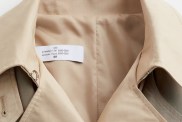Associated Press Writer, Tokyo
Growing up – forget it. Looking sexy, too. And appearing as though you might have a pulse? Better to glow blue like porcelain, or break out the black lipstick.
Check out any place where young women hang out in Tokyo, and you are likely to find Lolitas. In fact, it’s hard to miss them.


The look is little girl, tea party cute, starting with black hair ribbons or tiny bonnets and moving to frilly dresses and thick platform boots or Mary Jane flats, often augmented with a lace umbrella to protect the as-milky-as-possible complexion on sunny days.

Designer Naoto Hirooka, whose brand h. Naoto is one of the main creative forces behind Gothic Lolita, said the whole Lolita look – like much of the anime culture with which it is intricately entwined – is an escape into a childish world of cute.
“I think many Japanese women feel intimidated by high fashion in the West and feel that they can never live up to the refined beauty that they feel Western women strive for,” he said. “So, instead, they shoot for a cute look, one that doesn’t require tall, curvaceous bodies and instead emphasizes girlishness.”

Hirooka said the escapism of Lolita is also a reaction against conformism and the expectations on young Japanese women to quietly assume their adult roles as wives or workers in this country’s male-dominated society.
“One of the salient points about Lolita is that it is really a fashion that is not intended to attract men,” he said. “The women are creating their own world into which they can get away from the pressures of the larger society.”
In a very prissy way, Lolita is street fashion. Fumiyo Isobe, co-founder of Baby, the Stars Shine Bright, a major Sweet Lolita brand name, said the style is inspired by Victorian porcelain dolls.
The idea, she said, is to dress as a child might have in London circa the late 1800s. Very little skin is exposed and the dresses tend to be about knee length, with long sleeves. Stockings or gloves cover legs and hands.
The variation spirals off from there, though the pursuit of cute – a recurring theme throughout Japanese youth culture, from Hello Kitty to French Maid cafes – is at the core of any Lolita look.


In large part because of the growing popularity of Japanese anime, there is an increasing interest in Gothic Lolita abroad. Isobe’s brand is now preparing for a show in San Francisco, and Hirooka, who dressed Evanescence lead singer Amy Lee for the 2004 Grammys, is testing the waters of Los Angeles.
The Gothic & Lolita Bible – a quarterly magazine with a circulation of more than 100,000 – began an English edition for sale in the U.S. this year.
But Lolita isn’t looking to take the world by storm.
Iconic as they are here, Lolita brands aren’t designed for export – they are too fine-tuned to the frustrations of women in Japan, and their rebellion against them.

Photos courtesy of the Fashion Spot forums.






